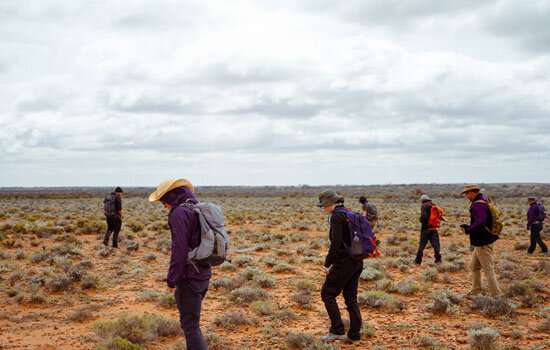Spy satellites, weather radars, and drones used to find new strewn field of meteorites

A field team led by Professor Andy Tomkins from the School of Earth, Atmosphere and Environment at Monash University has found the largest meteorite strewn field in Australia since the famous Murchison meteorite fall in 1969.
On July 31, 2013, U.S. Department of Defense satellites picked up an unusually large atmospheric explosion, equivalent to 220 tons of TNT, estimated by researchers to have been a six- ton asteroid, 1.5 meters in diameter.
Dr. Hadrien Devillepoix from Curtin University's Space Science and Technology Center (SSTC) recognized an opportunity to find meteorites on the ground resulting from this explosion. The Bureau of Meteorology had recently made its weather radar data openly available for research, under the initiatives of Dr. Joshua Soderholm. In the U.S., weather radars have been used to track meteorites as they fall and define a search area on the ground.
"We were very excited because a few meteorites have been found using this method using the U.S.'s radar network," Dr. Devillepoix said, "and if we were to find any from this event, it would be the first time that has been achieved elsewhere."
Using these techniques, Dr. Devillepoix calculated a likely fall zone (a "strewn field") on the ground where meteorite samples were most likely to be found—a six-kilometer long ellipse north of Port Augusta, SA.
"A strewn field is an area on the ground where meteorites from the same asteroid can be found," said Professor Tomkins.
Professor Tomkins has extensive experience leading field searches for meteorites on the Nullarbor Plain and collaborates with the Desert Fireball Network (DFN) team from Curtin University.
Armed with the treasure map, a field team from Monash, led by Professor Tomkins, made their way to the site and found the first meteorites within 10 minutes of searching. Over a period of several days 44 meteorites were recovered, totaling a little over four kilograms in mass.
"This discovery is very exciting because it's the first meteorite strewn field resulting from a new fall event to be defined since the famous Murchison meteorite fall in 1969," Professor Tomkins said.
Field team member, Seamus Anderson from Curtin University's SSTC has recently developed a novel technique to identify meteorites in drone images using machine learning.
"This is an amazing opportunity to refine our approach to meteorite recovery," Mr. Anderson said, "it typically takes a search team hundreds of hours to fully search such a large area—a drone can do it in less than a day."
"This is a world first," Mr. Anderson said, "using artificial intelligence and machine learning to map a meteorite strewn field."
With this new approach, scientists can combine both the weather radar and all sky camera network techniques to produce more precise calculations of the orbital origin of meteorites.
"This gives us an entirely new tool to track meteorites and where they come from," said Dr. Eleanor Sansom, manager of the DFN team at Curtin's SSTC.
Scientists from Monash have carefully collected meteorites to avoid any contamination by microbes from outside the natural environment where the meteorites were found.
"This is the perfect opportunity to undertake the first study of how microbes interact with a newly fallen meteorite," said microbiologist Dr. Rachael Lappan from Monash University.
"We think that as microbes first move into a new environment, they initially survive by consuming minerals and even gases from the atmosphere—this is the ideal opportunity to test out those concepts," she said.
"This is such a rare event," said Mr Ben McHenry from the South Australian Museum, "we're very excited to put these meteorites on display; it's great that we can have this collaboration between the universities and museums to share the excitement with everybody."
"The South Australian Museum will be showing several meteorites recovered from the new strewn field at its Six Extinctions exhibit, which is opening on Saturday the 26th of November, and we encourage everyone to come down and take a look."
"Because this event happened in the daytime, and a whole year before the DFN started monitoring the skies, it really shows the value of open datasets," Dr. Devillepoix said.
"Without people like Dr. Soderholm or the person who lobbied the US DoD to publish bolide data, thinking outside of the box and anticipating that the data could have other applications, this would not have been possible."
Scientists from Monash and Curtin are undertaking further research on the meteorites, and looking to apply the radar technique to other meteorite falls.
Provided by Monash University





















